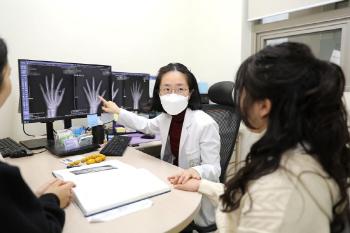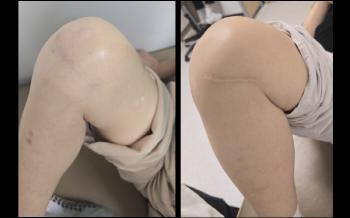Development of a Model for Predicting Hepatic Cancer of Metabolic Fatty Liver Diseases
Domestic researchers have developed and announced a new liver cancer risk prediction model for patients with 'metabolic fatty liver disease'.
Professor Lee Min-jong and Professor Kim Seung-up of Severance Hospital led the research team at Ewha Womans University Seoul Hospital on the prediction of a new risk of hepatic cell carcinoma in metabolic abnormal fatty liver disease: Clinical Gastroenterology and Hepatology A novel risk prediction model for hepatocellular carcinoma in MASLD: A multinational, multicenter cohort study)' is published in the recent issue of the online edition of the prestigious international journal of gastroenterology 'Clinical Gastroenterology and Hepatology' (Citation Index IF=12.0).
This study was conducted through joint research at five domestic institutions, including Ewha Womans University Seoul Hospital and Severance Hospital, and 15 institutions in the United States, Europe, and Asia.
'Metabolic fatty liver disease' is a disease that builds up fat in the liver related to metabolic diseases such as obesity and diabetes, and its prevalence is increasing with the increase of metabolic diseases. In particular, it is a major risk factor for liver cancer, and liver cancer can occur without cirrhosis, so it is a disease that requires active prevention and early monitoring strategies.
The research team closely analyzed data on a total of 77,677 patients with metabolic abnormal fatty liver disease, and found that obesity and diabetes are independent risk factors for liver cancer among the five cardiovascular metabolic risk factors, along with age, male, and low platelet levels.
In addition, the new liver cancer prediction model developed using five risk factors, including obesity and diabetes, showed a better prediction performance than the existing models with a C-index (Concordance index) of 0.835 and a higher prediction of 0.926 in external validation evaluation of patients in the United States, Europe, and Asia. In particular, the predictions were significantly higher than the existing predictive models 'Agile 3+' and 'Agile 4' in the patient group that needs to be referred to a liver disease specialist due to the severe liver fibrosis.
This study is of great clinical significance in that it presented an excellent and highly utilized predictive model to identify high-risk groups for liver cancer
Professor Jeon Ho-ho and Lee Min-jong of the Department of Gastroenterology at Ewha Womans University Seoul Hospital confirmed for the first time that there are differences in the effect of five cardiovascular metabolic risk factors on the incidence of liver cancer in patients with metabolic abnormal fatty liver diseaseIt was confirmed that among the five metabolic risk factors, controlling obesity and diabetes is very important in preventing liver cancer", he explained.
Professor Lee Min-jong and Professor Kim Seung-up of Severance Hospital led the research team at Ewha Womans University Seoul Hospital on the prediction of a new risk of hepatic cell carcinoma in metabolic abnormal fatty liver disease: Clinical Gastroenterology and Hepatology A novel risk prediction model for hepatocellular carcinoma in MASLD: A multinational, multicenter cohort study)' is published in the recent issue of the online edition of the prestigious international journal of gastroenterology 'Clinical Gastroenterology and Hepatology' (Citation Index IF=12.0).
This study was conducted through joint research at five domestic institutions, including Ewha Womans University Seoul Hospital and Severance Hospital, and 15 institutions in the United States, Europe, and Asia.
'Metabolic fatty liver disease' is a disease that builds up fat in the liver related to metabolic diseases such as obesity and diabetes, and its prevalence is increasing with the increase of metabolic diseases. In particular, it is a major risk factor for liver cancer, and liver cancer can occur without cirrhosis, so it is a disease that requires active prevention and early monitoring strategies.
The research team closely analyzed data on a total of 77,677 patients with metabolic abnormal fatty liver disease, and found that obesity and diabetes are independent risk factors for liver cancer among the five cardiovascular metabolic risk factors, along with age, male, and low platelet levels.
In addition, the new liver cancer prediction model developed using five risk factors, including obesity and diabetes, showed a better prediction performance than the existing models with a C-index (Concordance index) of 0.835 and a higher prediction of 0.926 in external validation evaluation of patients in the United States, Europe, and Asia. In particular, the predictions were significantly higher than the existing predictive models 'Agile 3+' and 'Agile 4' in the patient group that needs to be referred to a liver disease specialist due to the severe liver fibrosis.
This study is of great clinical significance in that it presented an excellent and highly utilized predictive model to identify high-risk groups for liver cancer
Professor Jeon Ho-ho and Lee Min-jong of the Department of Gastroenterology at Ewha Womans University Seoul Hospital confirmed for the first time that there are differences in the effect of five cardiovascular metabolic risk factors on the incidence of liver cancer in patients with metabolic abnormal fatty liver diseaseIt was confirmed that among the five metabolic risk factors, controlling obesity and diabetes is very important in preventing liver cancer", he explained.
|
This article was translated by Naver AI translator.




